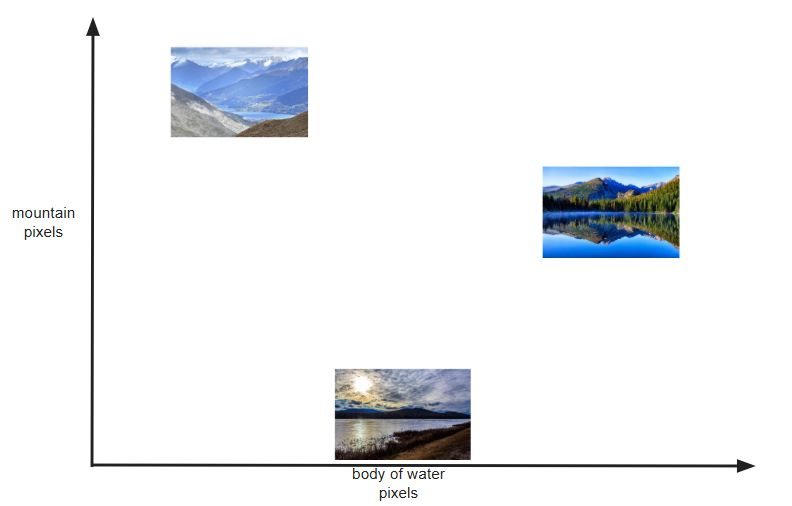Students explore the "AI effect", think about measuring similarity, and then consider characterizations of AI in popular culture.
Lesson Goals |
Students will be able to…
|
Student-facing Lesson Goals |
|
Materials |
|
🔗Measuring Similarity
Overview
Students discover the challenges of defining AI, and then consider what it means to measure similarity.
Launch
You’ve probably heard some buzz about Artificial Intelligence, or AI. The goal of AI is to enable a computer to perform tasks that typically require human intelligence.
-
What are some books, movies, TV shows, or video games you know of that feature AI?
-
Some possible responses include 2001: A Space Odyssey, The Wild Robot, Afraid, Star Trek, The Matrix, Star Wars, Terminator, Wall-E, Iron Man, Big Hero 6, The Mitchells versus the Machines, Blade Runner, I Robot, Mission Impossible, Upload, Person of Interest, The Good Place, The Hitchhiker’s Guide to the Galaxy
AI is what makes ChatGPT (and many other things!) work.
But what counts as AI?
-
In groups of 3-4 students, decide whether the different types of technology (listed below) are examples of AI or not.
-
spelling and grammar checking technology
-
plagiarism detection technology
-
self-driving cars
-
chess playing technology
-
song and video recommendation technology
-
Google Translate
-
Google Maps
-
-
After you have sorted the items above into AI / Not AI, come up with an answer to the question, "What counts as AI?" Put another way: What criteria did you look for when deciding if something is AI or not?
The purpose of this activity is to invite students to share what they think AI is: to surface both prior knowledge and misconceptions.
For students who want or need to know: All of the technologies above utilize Machine Learning, the set of techniques that drives modern AI. Whether we refer to each of these seven technologies as AI or not is up for debate, as the lesson will explain.
-
What criteria did your group look for when deciding if something is AI or not?
-
Responses will vary.
-
If students asked themselves whether human intelligence was needed to complete each task, highlight the inherent messiness of this approach.
 As different technological innovations become more familiar and more accessible… we stop thinking about them as AI. Computer scientist John McCarthy developed the term AI effect to describe this phenomenon. According to McCarthy, humans often adjust either the definition of AI or the concept of intelligence to exclude capabilities that AI systems have mastered. In his words, "As soon as it works, no one calls it AI anymore."
As different technological innovations become more familiar and more accessible… we stop thinking about them as AI. Computer scientist John McCarthy developed the term AI effect to describe this phenomenon. According to McCarthy, humans often adjust either the definition of AI or the concept of intelligence to exclude capabilities that AI systems have mastered. In his words, "As soon as it works, no one calls it AI anymore."
-
Have you witnessed "the AI effect"? If so, what were the circumstances?
-
Responses will vary; invite students to share.
-
Virtual assistants like Siri and Alexa have become commonplace.
-
The idea of a self-driving car no longer seems as radical and futuristic as it did 5 years ago.
-
When Deep Blue beat reigning world chess champion Garry Kasparov in 1996, it was amazing. But the chess-playing expert system run on a unique purpose-built IBM supercomputer couldn’t do anything else besides play chess!
Modern AI is largely driven by a set of techniques called Machine Learning (ML for short). AI relies so deeply on Machine Learning that many computer scientists prefer to use the phrase "AI/ML" when discussing a certain sort of technology that increasingly pervades our world.
In Machine Learning, the computer analyzes lots of data, and then identifies patterns in that data using statistics. Machine Learning can be applied to an incredibly diverse set of data (data from fairy tales, pictures, movies, songs, etc). While AI is often spoken about like something "magical", Machine Learning is actually very concrete: it is a collection of algorithms — the instructions that tell a computer how to perform a task. In Machine Learning, those algorithms, however, have a special quality: They are data-driven algorithms, meaning that they produce better results when given more representative data.
Investigate
So: What criteria can we use in deciding if a particular technology is AI?
Many machine learning technologies use some method for measuring similarity!
-
Are two pictures similar if they’re the same size?
-
Are two pictures similar if they have the same amount of red in them?
-
Are two songs similar if they’re the same number of minutes long?
-
Are two stories similar if they’re both about ghosts?
-
What does it mean for two things to be "similar"?
-
Can two pictures, songs, or stories be "more similar" or "less similar" than two other things?
If two things can be "more similar" than two other things, that means similarity must be something we can measure!
But what does it mean to measure similarity?
To begin to answer this question, let’s look at some pictures!
Refer to the mountain landscapes as you complete the first section of Measuring Similarity
1 |
2 |
3 |
4 |
5 |
6 |
7 |
8 |
9 |
-
What similarities do the 9 photos have?
-
Responses will vary.
-
They all show mountains and sky.
-
The photos are all rectangular in shape, and the rectangles are all the same size.
-
The photos all make me want to visit the mountains.
-
What differences do the 9 photos have?
-
Some photos show a body of water, others do not.
-
Some photos include the sun, others do not.
-
Some photos show mountains with snow, others show mountains with grass.
-
The color palettes differ from photo to photo (blues, greens, whites).
-
Some mountains appear round while others appear pointy.
-
In some photos, the mountains occupy most of the photograph, while in others, the mountains are just a small fraction of what is represented.
Complete the second section of Measuring Similarity, "Sorting the Photos".
After students have completed this section of the worksheet, there is a good chance that they will want to know if they were "right" or "wrong." A class show of hands will likely spark interesting conversation as well.
-
Let’s vote about the first comparison (Q4):
-
Raise your hand if you thought Photo 2 was more similar to Photo 1.
-
Raise your hand if you thought Photo 3 was more similar to Photo 1?
-
-
Let’s vote about the second comparison (Q6):
-
Raise your hand if you thought Photo 5 was more similar to Photo 4.
-
Raise your hand if you thought Photo 6 was more similar to Photo 4?
-
-
How was the experience of identifying similar and different photos? Was it simple or challenging?
-
Student responses will vary. Some students may articulate that it was challenging to decide which similarities to prioritize, when they were able to identify similarities across all photos.
-
How confident are you in the decisions you made on the second section of the Measuring Similarity?
-
Student responses will vary, and will likely be influenced by your class-wide opinion as revealed by show of hands (above).
Let’s think about another way of measuring similarity.

-
What do you Notice about the coordinate plane image?
-
Only the first quadrant is visible.
-
The x-axis is "body of water pixels", or how much space the body of water occupies in the photograph.
-
The y-axis is "mountain pixels", or how much space the mountains occupy in the photograph.
-
There are three mountain landscapes (numbers 1, 5, and 7) positioned at various points on the coordinate plane.
-
What do you Wonder about it?
-
How were the labels on the axes determined?
-
Where would I put the other landscapes on this coordinate plane?
-
How can I position landscapes that do not have any body of water in them?
-
Where do you think Photo 2 belongs on this coordinate plane?
-
Invite a student to the board to identify where Photo 2 goes.
-
It should have a similar y-coordinate and a slightly greater x-coordinate.
Complete the third section of Measuring Similarity, "Using the Coordinate Plane".
You discovered two different ways of measuring similarity as you worked with the nine different mountain images.
-
Summarize the first way that you measured similarity. You may want to refer back to the second section of Measuring Similarity, "Sorting the Photos".
-
Possible response: First I brainstormed what made all of the photos similar and different. Then, I compared one photo with two others. Usually, I had a gut reaction about which of the two photos were more similar to the first one. To describe and defend my answer, I had to pinpoint which characteristics caused me to see the similarity (e.g., color, presence/absence of water, etc). Sometimes, I had to think about which characteristics were more important.
-
Summarize the second way that you measured similarity. You may want to refer back to the third section of Measuring Similarity, "Using the Coordinate Plane".
-
In the second method of measuring similarity, I placed the photos on a coordinate plane. For the given coordinate plane, the axes provided were "mountain pixels" and "body of water pixels". If two photos were similar in that the both had a large body of water, they would have a close horizontal position on the coordinate plane.
Synthesize
-
How were the two ways you measured similarity alike? How were they different?
-
The two methods both involved thinking about the same nine images of mountain landscapes.
-
The two methods both required honing in on certain characteristics of those photos.
-
The second method required me to think about distance and space, while the first method did not.
-
In the first method, I needed to compare two images with one another before making a decision.
🔗Thinking about AI in Pop Culture
Overview
Students consider messages from various media about AI.
Launch
Many characterizations of AI envision technology that doesn’t exist yet. The futuristic (often dystopian) AI imagined in movies, video games, and books can sometimes interfere with the way that we understand the technology of the present.
Let’s consider what sort of AI information we’ve absorbed just by consuming books, movies, TV, and video games, along with our own personal opinions.
-
With a partner, choose one book / movie / TV show / video game that features AI.
Investigate
-
With your partner, identify one of the messages about AI from the list below that the book / movie / TV show / video game you picked supports.
-
AI must be safely controlled at all times.
-
AI could lead to social isolation.
-
AI can help us understand what it means to be human.
-
AI can help advance humanity and scientific discovery.
-
AI may pose a threat to humanity.
-
AI can perpetuate biases and lead to unfair outcomes.
-
Humans are helpless in the face of AI.
-
-
Discuss how the media you picked supports the message.
-
Record your thinking on Thinking about AI in Pop Culture.
-
Share your reflections with the class.
Synthesize
-
What are some questions that you have about Artificial Intelligence and/or Machine Learning that you’d like to learn more about?
-
What confuses you about AI/ML?
Consider writing down students' questions and possible misconceptions about AI. You can revisit these questions as answers emerge in subsequent lessons. If there are questions that surface that might inform future Bootstrap lesson development, we’d love for you to share them with us at contact@bootstrapworld.org!
These materials were developed partly through support of the National Science Foundation, (awards 1042210, 1535276, 1648684, 1738598, 2031479, and 1501927).  Bootstrap by the Bootstrap Community is licensed under a Creative Commons 4.0 Unported License. This license does not grant permission to run training or professional development. Offering training or professional development with materials substantially derived from Bootstrap must be approved in writing by a Bootstrap Director. Permissions beyond the scope of this license, such as to run training, may be available by contacting contact@BootstrapWorld.org.
Bootstrap by the Bootstrap Community is licensed under a Creative Commons 4.0 Unported License. This license does not grant permission to run training or professional development. Offering training or professional development with materials substantially derived from Bootstrap must be approved in writing by a Bootstrap Director. Permissions beyond the scope of this license, such as to run training, may be available by contacting contact@BootstrapWorld.org.









